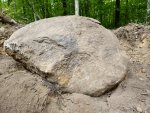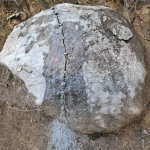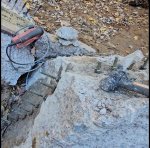Granite. I was on 3 wheels even with the weight box fully loaded and needed 4WD just to move. The other side is actually much taller:Haha the angle of the photo makes it look like that rock or chunk of concrete look bigger than the tractor!
What did you do to or on your Kubota today?
- Thread starter gurn
- Start date
It's impressive! I seen videos of folks moving heavy stuff with th sub compacts with no rear tires touching the ground. Crazy.Granite. I was on 3 wheels even with the weight box fully loaded and needed 4WD just to move. The other side is actually much taller:
View attachment 164354
This came from the marketing department. Engineering would have said "energy gain x at y F/°C"Says "for extremely low temperatures".
Brilliant picture !
Reminds me of some creature from a horror movie, with glowing eyes and huge claws
That you can move this size rocks with your tractor is most impressive
Last edited:
Thank you.Brilliant picture !
Reminds me of some creature from a horror movie, with glowing eyes and huge claws
That you can move this size rocks with your tractor is most impesssive
It is beyond the tractor's rated capacity, that is perhaps 1/12 of the rock that must be moved to drill a new well. The front right tire was displeased, and I drove very slowly and carefully.
To start with I split the rock into quarters (with some unfortunate fractures), this is the far side:
Then split each 1/4 of the near side into halves, so each piece is 1/8 of the rock...or more like 1/10 due to fractures on the far side:
After removing the top pieces, (the parts on the right are from fractures during the initial quartering)
I split the near side bottom in halves:
The front left part is the piece in the original picture I posted, most of it was underground, which is the brown part on the left in the following picture taken when pulling it out, the grapple grabbing the top part:
That piece was, uh, deceptively big.
Unfortunately the whole weight of the tractor and load is then on the poor front axle ... A good way to be getting fresh new seals at a very minimum ...It's impressive! I seen videos of folks moving heavy stuff with th sub compacts with no rear tires touching the ground. Crazy.
Yup, especially if you do it often. That's why I kinda like my L2501. That front axle is massive, gives me a little bit of piece of mind. Not that I lift up things that are too heavy. I haven't seen my front tires depressed yet.Unfortunately the whole weight of the tractor and load is then on the poor front axle ... A good way to be getting fresh new seals at a very minimum ...
This might have been a good job for DEXPANThank you.
It is beyond the tractor's rated capacity, that is perhaps 1/12 of the rock that must be moved to drill a new well. The front right tire was displeased, and I drove very slowly and carefully.
To start with I split the rock into quarters (with some unfortunate fractures), this is the far side:
View attachment 164355
Then split each 1/4 of the near side into halves, so each piece is 1/8 of the rock...or more like 1/10 due to fractures on the far side:
View attachment 164358
After removing the top pieces, (the parts on the right are from fractures during the initial quartering)
I split the near side bottom in halves:
View attachment 164356
The front left part is the piece in the original picture I posted, most of it was underground, which is the brown part on the left in the following picture taken when pulling it out, the grapple grabbing the top part:
View attachment 164357
That piece was, uh, deceptively big.
Without seeing the filler, can't say much except maybe a 90° fitting would help? No need to remove two filters together and challenge the vacuum's capability. Just replace one at a time. I've used the vacuum method and would bet I lost less fluid with that method.Yes, I have thought about it. But, I have hardly enough room to get a very looong skinny funnel into the fill opening let alone a vac hook up. Also the filters are right a the bottom with 10 gallons sitting above - seems like a partial vacuum and two filters might be a reach ?? But that is just a feel. My method is easy enough so I haven't felt the desire to try.
gg
I looked into DEXPAN (from another post here I think), it creates about 18,000 pounds of force per hole. Wedges are good for 15,000# with a 3# hammer, 20K with a bigger hammer--but the wedge gets damaged from any bad hit. The benefit of wedges is controlling the sheer line by feel, which, once you get the feel for it, is quick and pretty easy, and requires far fewer wedges and therefore fewer holes than DEXPAN, and therefore less time and cost.This might have been a good job for DEXPAN
Before:

(left)

(right)

(near)

(near, with wedges)
After:

Mind you only 1/3 to maybe if I'm lucky 1/2 of the rock is visible.
The trick is to not bang wedges like in tree work, but to tap and listen to each wedge, then tap the wedges that you want to steer the sheer line with once, then tap a neighbor once, and continue the process like that.
Exactly. But once it was pulled out it was a little late, only 1/3 that weight was expected.Unfortunately the whole weight of the tractor and load is then on the poor front axle ... A good way to be getting fresh new seals at a very minimum ...
I love your videos, and your tractor.Yup, especially if you do it often. That's why I kinda like my L2501. That front axle is massive, gives me a little bit of piece of mind. Not that I lift up things that are too heavy. I haven't seen my front tires depressed yet.
Last edited:
Unreal!The trick is to not bang wedges like in tree work, but to tap and listen to each wedge, then tap the wedges that you want to steer the sheet line with once, then tap a neighbor once, and continue the process like that.
And the size of this rock!
How long did it take you to dig it out, split it into pieces and move it with the tractor?
Without seeing the filler, can't say much except maybe a 90° fitting would help? No need to remove two filters together and challenge the vacuum's capability. Just replace one at a time. I've used the vacuum method and would bet I lost less fluid with that method.
The filler plug is that reddish smudge below and behind the rear remote QD's and valve and hose.
With two guys telling me I should try it then maybe I should. How tight of a connection to you need on the vac hose ??
gg
I'm impressed what the BX tractors can do. I thought they were equivalent size of the 1023/25R tractors from John Deere but I didn't know they were actually bigger. The BX machines are even smaller which is even more impressive.I looked into DEXPAN (from another post here I think), it creates about 18,000 pounds of force per hole. Wedges are good for 15,000# with a 3# hammer, 20K with a bigger hammer--but the wedge gets damaged from any bad hit. The benefit of wedges is controlling the sheer line by feel, which, once you get the feel for it, is quick and pretty easy, and requires far fewer wedges and therefore fewer holes than DEXPAN, and therefore less time and cost.
Before:
View attachment 164372
(left)
View attachment 164371
(right)
View attachment 164374
(near)
View attachment 164373
(near, with wedges)
After:
View attachment 164370
Mind you only 1/3 to maybe if I'm lucky 1/2 of the rock is visible.
The trick is to not bang wedges like in tree work, but to tap and listen to each wedge, then tap the wedges that you want to steer the sheet line with once, then tap a neighbor once, and continue the process like that.
Exactly. But once it was pulled out it was a little late, only 1/3 that weight was expected.
I love your videos, and your tractor.
I don't like a tight fit and let a fair amount of air to leak into the vacuum. If you pull a high vacuum debris can be pulled in past seals and past the loosened filter.How tight of a connection to you need on the vac hose ??
gg
Still working on it, 3 weekends splitting and moving so far. It would take less if I knew what I was doing, but it's "learn as you go." I watched a guy on YouTube split a rock the size of his foot with three wedges, I thought, "I just need more wedges."Unreal!
And the size of this rock!
How long did it take you to dig it out, split it into pieces and move it with the tractor?

The L3901Dt has 7.5 gal and the shop-vac was able to hold it back.Yes, I have thought about it. But, I have hardly enough room to get a very looong skinny funnel into the fill opening let alone a vac hook up. Also the filters are right a the bottom with 10 gallons sitting above - seems like a partial vacuum and two filters might be a reach ?? But that is just a feel. My method is easy enough so I haven't felt the desire to try.
gg
Do you have a cab tractor that it is hard to get a funnel into the fill opening?
I assume you're discussing changing hydraulic filters? I changed mine using the shop vac method. It worked great, hardly lost any fluid. Although the shop vac did suck up someThe L3901Dt has 7.5 gal and the shop-vac was able to hold it back.
Do you have a cab tractor that it is hard to get a funnel into the fill opening?
I was afraid of my shop-vac sucking fluid when I did my 50 hr service. Did it the old fashioned way, remove and quick spin new filter on. Only lost about a quart, then I asked myself, did the new filter come with a magnet like the old one?
So instead of asking or researching, I gently removed the new filter, saw a magnet and spun it right back on. Causing me to lose another 1-2 qts of fluid. All in all I used almost a gallon of UDT2 fluid.
Today after riding with a couple friends, I prepped the track for the next weekend ride. Season is coming to an end, so days like these I'm grateful.

So instead of asking or researching, I gently removed the new filter, saw a magnet and spun it right back on. Causing me to lose another 1-2 qts of fluid. All in all I used almost a gallon of UDT2 fluid.
Today after riding with a couple friends, I prepped the track for the next weekend ride. Season is coming to an end, so days like these I'm grateful.
When I said it sucked fluid, not like it sucked muchI was afraid of my shop-vac sucking fluid when I did my 50 hr service. Did it the old fashioned way, remove and quick spin new filter on. Only lost about a quart, then I asked myself, did the new filter come with a magnet like the old one?
So instead of asking or researching, I gently removed the new filter, saw a magnet and spun it right back on. Causing me to lose another 1-2 qts of fluid. All in all I used almost a gallon of UDT2 fluid.
Today after riding with a couple friends, I prepped the track for the next weekend ride. Season is coming to an end, so days like these I'm grateful.
View attachment 164403
Had I been wiser, I would have only lost one quart. The price was peace of mind for me.
That said, I'll try the shop-vac method next time at my 200 hr service.
That said, I'll try the shop-vac method next time at my 200 hr service.

